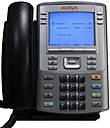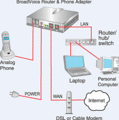Voice over Internet Protocol facts for kids
Voice over Internet protocol (or VoIP) is a term used for a number of protocols that are used to carry voice data over packet switched networks. Beforehand, telephony used a dedicated line, that was only for calls. This was known as PSTN (or "public switched telephony network"). Using VOIP will reduce costs, as the "dedicated line" for telephony (and fax) is no longer needed.
There are a number of technical problems that must be solved first, though:
- Carrying voice data needs a service guarantees (mostly in the form of "throughput", and "response time"). Not having this will result in a loss of signal (or in "hiccups")
- Most telephony network provide the possibility to operate a phone, even when the power is lost in the area. This is done so that emergency calls can still be made. VOIP usually does not provide this possibility.
- The LAN is now used both for voice and data, and becomes a single point of failure. If there are problems with the LAN, this can also affect VOIP calls.
- The encoding schemes used for voice calls are not good choices for fax or other uses of the telephony network.
Images for kids
See also
 In Spanish: Voz sobre protocolo de internet para niños
In Spanish: Voz sobre protocolo de internet para niños

All content from Kiddle encyclopedia articles (including the article images and facts) can be freely used under Attribution-ShareAlike license, unless stated otherwise. Cite this article:
Voice over Internet Protocol Facts for Kids. Kiddle Encyclopedia.



